Mesa Verde National Park
Overview
Mesa Verde National Park is a United States National Park and UNESCO World Heritage Site located in Montezuma County, Colorado. The park was created in 1906 to protect some of the best-preserved Ancestral Puebloan archaeological sites in the United States. It occupies 52,485 acres near the Four Corners region of the American Southwest, and with more than 600 cliff dwellings, it is the largest archaeological preserve in the U.S.


History
The history of Mesa Verde National Park is a fascinating blend of ancient cultures and modern exploration. The park's earliest inhabitants were the Ancestral Puebloans, who lived in the area from approximately 600 to 1300 AD. The park's rich archaeological history was largely unknown until the late 19th century when local ranchers and prospectors began discovering artifacts and structures. In 1888, two cowboys stumbled upon Cliff Palace, sparking interest in the area and leading to its eventual designation as a national park.
Geology
The geology of Mesa Verde National Park is characterized by its high plateaus, deep canyons, and the cliff dwellings that the Ancestral Puebloans carved into the sandstone and shale. The park sits on the Colorado Plateau, a geological region characterized by layered sedimentary rock and uplifted by tectonic activity. The park's geology played a crucial role in the lives of its ancient inhabitants, providing both shelter and resources.
Archaeological Sites
Mesa Verde National Park is renowned for its well-preserved archaeological sites, including cliff dwellings, pueblos, and kivas. The most famous of these is Cliff Palace, the largest cliff dwelling in North America. Other significant sites include Balcony House, Spruce Tree House, and Long House. These sites offer a glimpse into the lives of the Ancestral Puebloans, showcasing their architectural skill, cultural practices, and adaptation to the environment.
Flora and Fauna
The park's diverse ecosystems support a variety of flora and fauna. The vegetation ranges from lowland desert plants to high-altitude coniferous forests. The park is home to numerous species of mammals, birds, reptiles, and insects. Notable species include the mule deer, coyote, mountain lion, and peregrine falcon.
Tourism
Mesa Verde National Park attracts tourists from around the world, drawn by its rich history, unique geology, and diverse flora and fauna. The park offers numerous recreational activities, including hiking, camping, wildlife viewing, and guided tours of the archaeological sites. The park's visitor center provides educational exhibits and resources to enhance the visitor experience.
Conservation
The park's designation as a national park and UNESCO World Heritage Site reflects its significant cultural and natural value. Conservation efforts in the park focus on preserving its archaeological sites, protecting its diverse ecosystems, and managing tourism to minimize impact on the park's resources.
